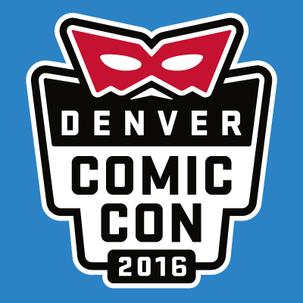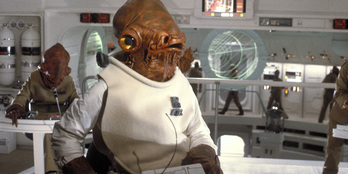Written by Tim Girard Behind-the-Scenes at Skywalker Ranch Sunday, June 19, 2016 1:30pm-2:20pm Matthew Wood, David Acord You may not immediately recognize the names David Acord and Matthew Wood, but if you check the credits for the Star Wars prequels, the Star Wars: The Clone Wars animated series, the Star Wars Rebels animated series, as well and the credits for Star Wars: Episode VII - The Force Awakens, you'll realize that you've heard their sounds and their voices...a lot. They have worked at Skywalker Ranch doing sound design and voice acting on almost all of the "modern" Star Wars media. They graciously spent most of the panel answering questions from the audience, and while I'm sure most of the questions posed during the panel they've heard many times before and since, there were a few surprises. The first audience member wanted to know about the sound in Star Wars: Episode II - Attack of the Clones when Obi Wan was pursuing Jango Fett and Jango was releasing seismic charges. A murmur from the crowd let me know that this was a favorite sound of many of the audience members. Instead of going into an in-depth discussion of advanced audio synthesis and editing, Wood told a funny story about it. Some time after that sound had been submitted for the final mix and they had moved onto other projects, Wood got a panicked phone call from an editor saying that the sound at the beginning of the explosion was missing. Wood had to reassure them that the silence at the start of the explosion preceding the "BRAAAAAM" was intentional and that there was nothing missing. The next audience member wanted to know, "why are the prequels so bad?" This caused an awkward hush to fall over the crowd. Matthew Wood diplomatically took this one. He started by pointing out that good and bad are relative, and that he personally loves the prequels. He has fond memories of all of the time and hard work that he and his crew put in on them, and in his eyes they are great. He then went on to point out that, especially today with the anonymity that the internet/social media provide, it's easy to just hate something. It is easy to just dismiss something as bad, as opposed to taking the time to think about why something is good. Also, even if a majority of people can find at least one reason or another to love something, the voice of hate is usually the loudest, but that doesn't mean that it is right. His answer was met with a round of thunderous applause. To lighten the mood, they talked about some of their voice-over work. When there is a voice actor needed for a small part, the opportunity will be open to those who already work for Lucasfilm/Disney. When the part of General Greivous was posted, Wood auditioned under the name "Alan Smithee" (which some of you will know is the name directors will use if they don't want their real name attached to a project). At first he almost didn't get the job because no one knew who "A.S." was (they used initials to keep the auditions confidential), but luckily he heard about it and remembered that he had auditioned under the pseudonym. One of David Acord's most famous voice-over jobs was for the baton-wielding Stormtrooper FN-2199 (who was known as "TR-8R" before the character's real name was released). When Finn is first using the lightsaber, we hear the stormtrooper yell a single word before throwing his blaster and shield, in exchange for his baton. They laughed about how people kept coming up to their booth to have David yell his famous line. Matthew suggested that he do it once for the entire room so that he might save his voice by not having to do it for each of us individually later. David laughed and obliged us by taking a deep breath and shouting,"Traitor!" Again, the room erupted in applause. Another audience member asked them what the process was like whenever they work on a new film. First there is a spotting session where a group will watch the film together. This group will include people such as the director, editor, sound engineer, composer, etc. They then have a meeting to discuss where the dialogue is most important, where special effects will be used, where music should go, etc. The sound effects team will experiment with creating different sounds and send them to the director. The director will tell them which ones might work and which ones won't, and then they go back and try again, and repeat that process. Eventually the editors will add the sounds where they belong and then start to mix and blend them all together into a cohesive whole, keeping in mind which one of those is telling the story at any given moment: the dialogue, the effects, the music, or some combination of them. An interesting fact that might not occur to many people is that the costumes can have an effect on the audio. If there is a mask or a lot of facial prosthetics (or even if the clothes make a lot of noise), that can interfere with recording the dialogue. This means that the dialogue will have to be rerecorded in post-production in the studio. This can sometimes effect the performance, because the actor might be more preoccupied with matching their words to the movement of their mouth onscreen, and therefore not be as focused on delivering their most engrossing performance, and being in a sound booth by yourself, as opposed to being present with the other actors, all in costume and in character can also effect said performance. Another important part of postproduction is the foley stage, where they add many of the "organic" sound effects. It's a few people in a room full of random junk, watching the film and adding all of the little natural sounds that you probably don't notice, but would miss if they weren't there. If someone is walking on a wooden floor, they take shoes and tap them on wood, if someone is walking in the woods, they will crumble leaves, etc. This is done mostly because the microphones that record dialogue are meant to only record dialogue and hopefully no ambient sounds. The ambient sounds can't just be recorded at the time of shooting, because once the footage is edited, all of the background ambience would sound all chopped up. This is why they record it later, in the studio, when're they can have total control. One audience member asked if there was anything controversial about any of the audio in The Force Awakens. They said that Admiral Akbar's voice was a point of discussion. Tim Rose originally did the voice of Admiral Akbar in Return of the Jedi, and they had him reprise the role for The Force Awakens. Since over 30 years had passed in between films, Tim's voice had obviously changed, so the Akbar in The Force Awakens sounds much different than the one in Return of the Jedi. They were concerned that the audience might think that it was actually a different actor because he sounded different, and they considered altering his voice to make it sound more like the original. In the end, they decided that the character had also aged 30 years, so it was okay and natural that he wouldn't sound exactly the same, so they left Tim's recording unaltered.  Speaking of things from the original trilogy, they are currently working on updating the sound for Episodes IV, V, and VI. Wood let us in on an industry trick, which is, when you have a battle scene and there is laser fire going on in the background, they would use a tape loop of laser sounds that they would just add into the scene, to have a seemingly random sequence of laser sounds. Since the original loop is lost, they have to study and analyze those scenes to figure out where the loop happens and what the "rhythm" of laser sounds is, in order to recreate it digitally. This is so important, because they are sure that if they changed it from the original, even in the slightest, someone, somewhere would notice that, in one scene, where there is supposed to be three laser shots, now there are only two (he has probably written an entire dissertation on this scene, which depends on there being three laser shots). Although this creates so much more work and attention to detail for them, they don't mind, because that one fan's extreme attention to detail, just proves how important these films are to people. One audience member wanted to know what scene was their favorite to work on. Wood said that his was the pod race in Episode I. They had to create a different signature sound that fit the look of each pod racer. Also there were plenty of malfunctions, explosions, and pieces of pods tumbling that all needed sounds. His least favorite part however, is spending a lot of time crafting the perfect sound...only to have it cut. He also went on to talk more about just how important sound is to the Star Wars universe, and that it is because, according to Wood, "George is a sound guy." He sees the sounds as an integral part of his universe and that is why they are encouraged to take time to accumulate all of those great sounds. Some sounds are drawn from older, traditional sources, like the Wilhelm Scream, and all of the original sounds used in the original Star Wars trilogy. Other sounds are custom made from scratch and even use organic source material, such as FN-2199's baton, which at its source is the sound of pulling duct tape off of a surface. While some sounds might be created completely electronically, their preferred method is to have some sort of organic source for the sounds they create. For Kylo Ren's force sound, they wanted something that would be raw, rough, and inconsistent, since he is very powerful, but moody and untrained. They used the sound of David's cat, Pork Chop purring which they then lowered in pitch and added other effects to. The final topic of discussion was how they created BB-8's signature voice. It began with Ben Schwartz recording actual dialogue in English in all of the scenes when BB-8 is talking to someone. This helped to give everyone a better idea of what BB-8 was actually saying and feeling in every situation, as opposed to it being just boops and beeps from the very beginning. This also gave the dialogue a more organic rhythm and cadence that they could eventually layer the beeps and boops on top of. J.J. Abrams had a program that he could use to create and manipulate the boops and beeps, which was attached to a Peter Frampton talk box that allowed Bill Hader to change the shape of his mouth to further alter the sound. All this was so that when BB-8 has a conversation with R2-D2 at the end of the film, they have two distinct voices.
0 Comments
Leave a Reply. |
Archives
March 2025
|
|
© 2012-2025, Nerds That Geek LLC.
All Rights Reserved. |
uWeb Hosting by FatCow


 RSS Feed
RSS Feed